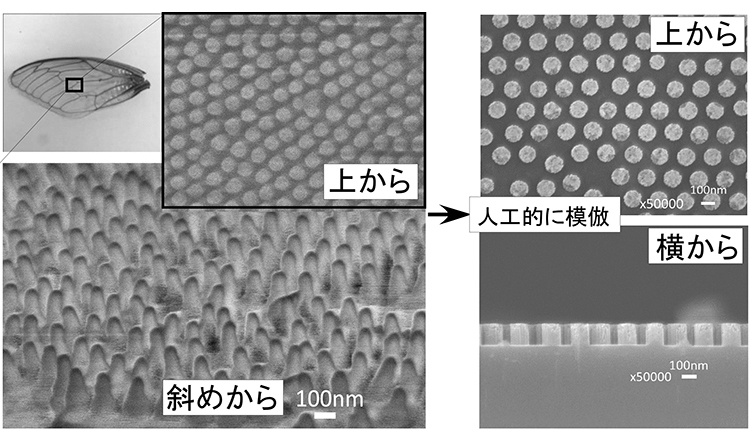三次元配線分野 3D-LSI
新宮原教授 Prof. Shingubara
LSI技術はパソコンや携帯電話などのIT機器の基盤技術として、40年以上にわたり目覚ましい発展を遂げてきました。21世紀に入って以降、LSIのさらなる高機能化・集積化には3次元化が必須であることが明らかとなってきました。最近では、高密度メモリにおいて3次元化が顕著ですが、近い将来には多機能LSIチップを積層した高速画像データ処理チップや高感度センサーと信号処理・送受信用通信チップなどが混載した高機能3次元LSIの実現が期待されています。これらの3次元実装技術においては、シリコンウエハの貫通ビア電極(TSV)形成技術が重要な技術課題となっています。本研究室では、新規な無電解めっき技術を用いて、微細なTSVの形成技術に取り組んでいます。
めっき技術は、ナノテクを牽引する重要なハイテク技術の一つです。我々は無電解銅めっきでもボトムアップ堆積が可能なことを世界で初めて見出しました。3次元LSIのTSV形成においては、従来のスパッタ法によるバリア層及びシード層形成では限界があり、低温プロセスかつ均一膜形成可能な無電解めっき技術が重要な鍵を握っています。我々は2011年に貴金属触媒を用いた無電解バリア層・銅シード層の形成によって、世界で初めてオールウエットTSV形成技術に成功しました(図)。この技術では、直径2μmの高アスペクト比TSVへの貴金属触媒ナノ粒子の高密度吸着が重要な技術です。なお、本研究テーマに関しては、企業との共同研究を展開しており、実用化に向けた検討を推進しています。 (References:Electrochemical Solid-State Letters 2004, Electrochimica Acta 2011, MEE 2013)
参考文献![]()
Si LSI technology has developed drastically for more than 40 years continuously. It realizes various IT tools such as personal computers, smart phones, digital cameras, etc. However, the trend of miniaturization called ‘Moor’s Law’ has slowed down in recent years because of explosion of cost and technological difficulties. Three dimensional (3-D) LSI is one of most important solutions to overcome limits of Moor’s Law. 3-D LSIs has been used for mass production of NAND Flash memories, and they will be widely used for highly functional chips combined with logic LSIs, MEMS sensors, nonvolatile memories, RAM, graphical processing units, etc in near future. TSV(through Si via) is a key technology for fabricating 3-D LSIs, however, there are many difficulties when its size shrinks and a aspect ratio of depth to diameter of TSV increases. Conventional technologies using sputtered barrier and seed layers will no longer survives in the high aspect ratio TSVs. We have developed electroless barrier and seed layer plating technologies (ELP) to overcome this problem, because film deposition in ELP is intrinsically surface reaction controlled and an excellent surface coverage is obtained even for a high aspect TSV. We proposed “all-wet TSV filling process” using ELP-deposited CoWB barrier and Cu seed layers on precious metal nanoparticle catalyst in 2011 as shown in the figure. We succeeded in the conformal deposition of barrier and seed layers by ELP for a fine TSVs with aspect ratio of more than 10. Furthermore, we continue to study this technology to realize more reliable and cost effective TSV fabrication by collaboration with companies (References:Electrochemical Solid-State Letters 2004, Electrochimica Acta 2011, MEE 2013)
Reference![]()

ナノメモリー素子分野 Nano-Memory
新宮原教授 Prof. Shingubara
今日では、NAND型フラッシュメモリに代表される不揮発メモリが様々な電子機器において用いられています。メモリの大容量化・高速化・低消費電力化への技術要求は高く、フラッシュメモリに代わる新規なメモリ素子の検討が活発に行われています。その中でも、金属/金属酸化物/金属というシンプルなサンドイッチ構造で不揮発メモリ特性が発現可能な抵抗変化メモリ(ReRAM)は微細化が可能であり、高速書き込み・書き換え性においても優れています。またReRAMはメモリのみでなく、入力電圧刺激に対して抵抗変化応答を示すシナプス素子としても優れた特性を示す可能性があります。そこで我々はReRAMに関して、以下の二つの観点から研究を進めています。
The demand for nonvolatile memories such as NAND Flash increases year by year due to development of IoT technologies. There are intensive requirements for memories such as higher storage capacity, faster operating speed, smaller energy consumption. Therefore, new nonvolatile memories have been actively researched. ReRAM (resistive random access memories) is one of most actively researched nonvolatile memories having a simple structure of meta/insulator/metal sandwiched structure. ReRAM is suitable for miniaturization and fast switching and recently mass production as a storage class memory has started. Another possibility of ReRAM is for application to artificial neural devices such as synapse. In some operation mode, ReRAM is possible to change resistance continuously according to input voltage pulse signals, and this property is important to artificial synaptic device. From these points of view, we push researches regarding the following two topics.
ニューロコンピュータに向けたReRAMを用いたシナプス素子の作製と提案
金属酸化物(HfOx,TaOx, etc)を二つの金属電極間に有するReRAM素子において、酸素欠損による導電性フィラメントで動作するタイプ(OxRAM)、金属フィラメントで動作するタイプ(CB RAM)の双方を比較検討しつつ、入力電圧パルスに対してほぼ連続的に抵抗増加もしくは抵抗減少の反応を示し、かつ長期間安定に動作するシナプス素子を探索する。
Proposal and fabrication of synaptic device using ReRAM technology for neural computing
There are two types of ReRAM. The one is OxRAM operated with conductive filament composed of oxygen vacancies, and the other is CB (conductive bridge) RAM operated with metallic conductive filament. We have studied both types and comparing various properties. For realizing synaptic devices, a continuous resistance changes in accordance with input voltage pulse signals and its long time stability is very important. We have been studying to find the device structure and materials to fulfil these requirements.
新規なスピンメモリの可能性の追求
ReRAMにおける導電性フィラメントはそれ自身がナノ構造であるため、磁性体による導電性フィラメントが形成されます。新規なナノ磁性体では従来の概念とは異なる磁気伝導現象が発現する可能性もあり、そのような観点からも、磁性体層を電極に用いたReRAMにおける磁気伝導現象の評価を進めています。
Investigation of a new memory based on spintronics
In the ReRAM device having ferromagnetic electrode, we found that ferromagnetic conductive filament was formed. In the nanostructured ferromagnetic materials, there are possibilities of one dimensional conductance as well as single electron related phenomena. From these points of view, we have studied ReRAMs with ferromagnetic electrode to find a new device operating principle based on spin-related conduction.
Reference![]()
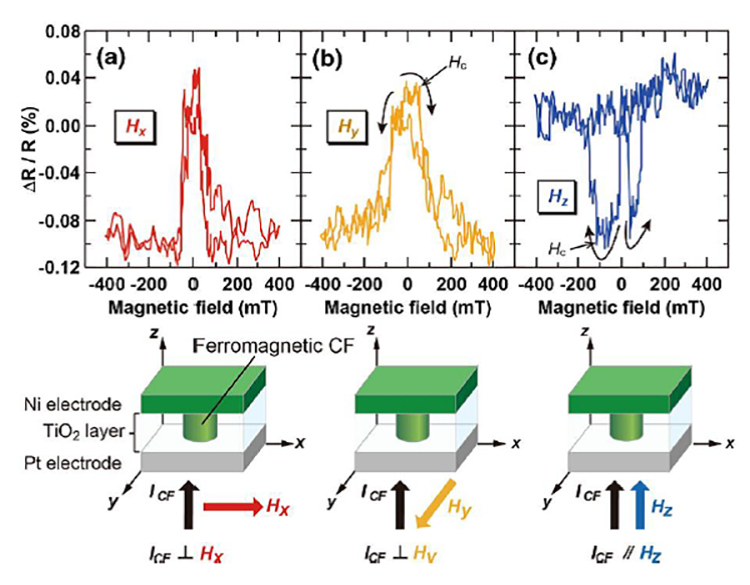
ナノ構造分野 Nano Materials
新宮原・伊藤・清水教授
物質をナノスケールまで小さくしていくと、大きな材料(バルク)とは異なる性質を示すようになります。このナノ構造分野では特にナノワイヤやナノホールなど一次元ナノ構造体を「自己組織化」を利用して形成する方法を研究しています。我々はナノ構造形成を基盤技術として、次世代メモリ素子、3次元配線、バイオ・化学センサー、バイオミメティックス、太陽電池などへの研究展開を行っています。その意味で、ナノ構造分野は本研究室活動の根幹を支える部分です。これまでシリコン基板上での陽極酸化アルミナ・ナノホール形成法技術、単結晶シリコンナノワイヤの成長方位制御技術など、独創的なナノ・マイクロ構造体の形成方法を確立してきました。これらの技術は世界でも高く評価され、国際共同研究や企業との共同研究に発展してきました。現在では、これまでのナノワイヤやナノホール形成に加え、CuSnナノツリーや金属触媒を用いたシリコンのエッチング加工技術など新たな研究を行っています。
Nano-sized materials are known to have excellent properties such as band gap widening and magnetic properties by quantum confinement effect. We have studied fabrication of these nano materials such as one dimensional nanowires and nanoholes by “self-organization” processes. We developed these technologies for fabrication of next generation nonvolatile memories, 3-dimensional interconnections, biochemical sensors, bio-mimetics, and solar batteries, etc. Our original technologies are; (1) formation of nanohole array on Si using anodic oxidation of sputtered Al films, (2) growth of single crystalline Si nanowires perpendicular to Si (001) substrate, (3) CuSn nanotrees formed by electroplating, etc. These topics have been developed by collaboration between foreign research institutes and Japanese companies. Recently we have started metal assist chemical etching (MacEtch) of Si aiming at TSV and Si nanowire formation.
陽極酸化アルミナを用いたナノワイヤ配列構造の形成
陽極酸化アルミナ(AAO)はアルミをアノード酸化すると得られる多孔質の被膜のことです。陽極酸化アルミナの孔(ナノホール)の直径は数nm~数百nmで、基板に対し垂直方向に配列成長します。このナノホールを鋳型として金属や半導体材料を埋め込み、細線材料(ナノワイヤ)を形成します。本研究室では様々な材料でのナノワイヤの形成や、ナノホールに埋め込んだ材料の結晶方位の制御に関する研究を行っています。参考文献![]()
AAO (anodic oxidation of aluminium) has been used by various researchers in the world. This is a simple technology uses pure aluminium film or plate with applying voltage in acidic solutions. It has been reported in the 1990s that the ordered array of nanoholes between a few tens to hundreds nm are formed perpendicular to substrate in oxalic acid, surfuric acid, and phousphoric acid. We deposited various materials such as metals and semiconductors by electroplating as well as electroless plating in the AAO nanoholes on Si o SiO2 substrate. These structures are very useful for biosensing devices as well as high density memories. Reference![]()
CuSnナノツリーの形成と成長メカニズムに関する研究
我々は銅と錫を特殊な条件下で同時にめっきすると、直径が数十ナノメートルスケールの枝を持つ樹枝状結晶が成長することを発見しました。この材料は各枝が高品質な単結晶であり、形状もユニークであることから、様々な用途への応用が検討されています。ナノ構造分野ではナノツリー材料の成長のメカニズムを調べ、異なる材料や形状の制御など用途に合わせたナノツリーの合成に役立てる研究をしています。 参考文献![]()
Formation of three-dimensional CuSn nanotree and investigation of its growth mechanism
We found that formation of nano-tree-like structures consisting of single crystal CuSn alloy nanowires branching perpendicularly from their parent branches. The nanotrees are being considered as various applications due to their unique structure and high-quality CuSn single crystal. We investigate a growth mechanism of the nanotree to contribute to control of the the intended shape of nanotree and to use other materials instead of Cu-Sn alloy. reference![]()
金属触媒を用いたシリコン基板の選択エッチング(メタルアシストエッチング)に関する研究
金や銀など貴金属を触媒として、フッ化水素酸などを含む溶液を用いるとシリコンを選択的にエッチングできます。我々はこの金属触媒の形やエッチング条件を工夫し、様々な形状のナノ・マイクロシリコン構造体を形成する研究を行っています。
Selective and high-aspect etching of semiconductor materials using metal-assisted chemical etching (MacEtch)
In MacEtch, Si is etched only at the interface of the Si and noble metal catalyst, which provides high selectivity and directionality for the etching of Si. Noble metals have been the dominant catalysts for MacEtch of Si substrate. We study about effects of the etching conditions for the formation of nano- micro-Si structure using MacEtch process.
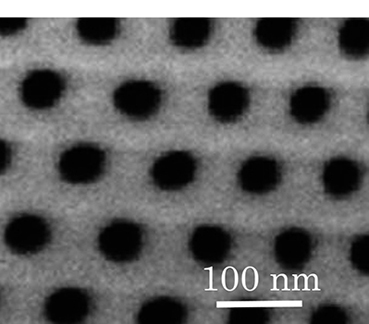

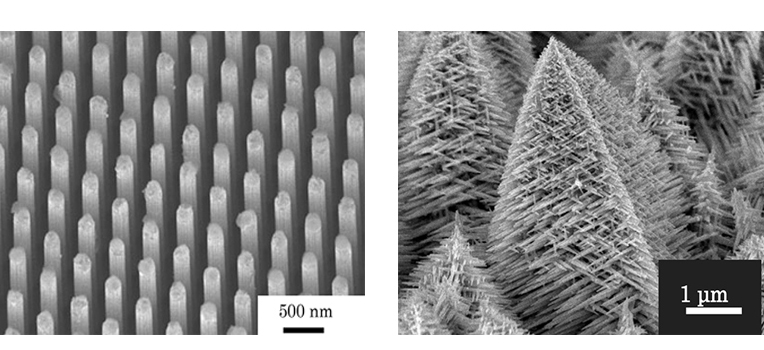
バイオセンサー(ケミカルセンサー)分野 Biosensor
伊藤教授 Prof. Ito
バイオセンサーに関わる技術は、機械工学、応用物理学、電子工学、分子生物学、分析化学、電気化学など多岐にわたり、学部で学んできたこと以外にも多くの知識が必要となります。学内外の協力者と共に教員を含めて勉強をしつつ新しい分野への挑戦を行っています。また、IoTがクローズアップされる現代では、センサーの利用法などにも着目することが必要で、例えば一次産業に向けたセンサーなど時代のニーズに応えるセンサーの開発が望まれています。
私たちのグループでは、今までに培ってきたナノ・マイクロ領域の材料創製技術であるトップダウン法、ボトムアップ法を活用しながら新規ナノ材料を創製し、それらの物理的・化学的特性を明らかにしていきます。また、それら新規材料を用いたケミカルセンサを構築し、センサシステムへと展開することを行っています。
Molecular interaction such as PPI (protein-protein interaction) is very important for living organisms to maintain the life activity. In particular, PPIs are studied for drug discovery and basic medicine. For monitoring PPIs, many techniques are suggested based on photo fluorescence. However, this technique needs to label fluorescence materials. To monitor PPIs on the real time, some techniques such as SPR (surface plasmon resonance) and QCM (quartz crystal microbalance) are widely spread. These techniques have sensing devices, in fact, biosensors. Our group develops devices to monitor PPIs and complicated deformation of biomolecules using LSPR (Localized Surface Plasmon Resonance) and QCM. We develop these devices to improve the sensitivity by using nano structures which have large surface area.
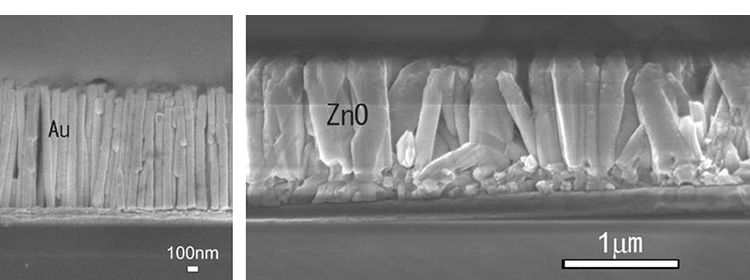
バイオミメティクス分野 Biomimicry
伊藤教授 Prof. Ito
生物がその進化の過程で得てきたその生物特有の特徴的な機能がクローズアップされています。バイオミメティクスは、そのような生物が持つ特徴的な機能を真似ることで人類に役立つ技術を創出する研究分野であり、バイオミミクリーなどとも呼ばれています。私たちは、特に生物の持つナノ・マイクロ構造とその機能に着目しています。これらの構造は、自己組織化されており、低環境負荷で作られるため工業的に見ても有用です。
現在は、セミの羽の表面にあるナノ構造に着目し、そのナノ構造が持つ抗菌性について研究を行っています。ボトムアップ技術を使ってシリコン基板上に無数のナノ構造を作製することで模倣に成功しました。また、このナノ構造を表面に持つシリコン基板は、大腸菌に対して抗菌性を示すことを明らかにしてきました。今後は、これらの大量生産へ向けた取り組みにより食品分野などへ展開していきます。
Biomimetics is one of the hot topics in the world. Recently, observation techniques such as SEM, TEM and AFM are widely spread, and we can use them easily to discuss the nano and micro-structures of living organisms. They acquire functional nano and micro structures along the course of evolution. In addition, nano and micro fabrication techniques based on top down process and bottom up process grow up. Then, we can fabricate nano and micro-structures to mimic that of living organism.
We pay attention for cicada’s wing because it shows the antireflection, super hydrophobic, low friction and antibacterial property. In particular, antibacterial property is very unique and expressed due to physicochemical property of its structure. Our group fabricates Si nanopillars by metal assisted chemical etching and shows their antibacterial property. Now, we try to work out the mechanism of antibacterial property.
